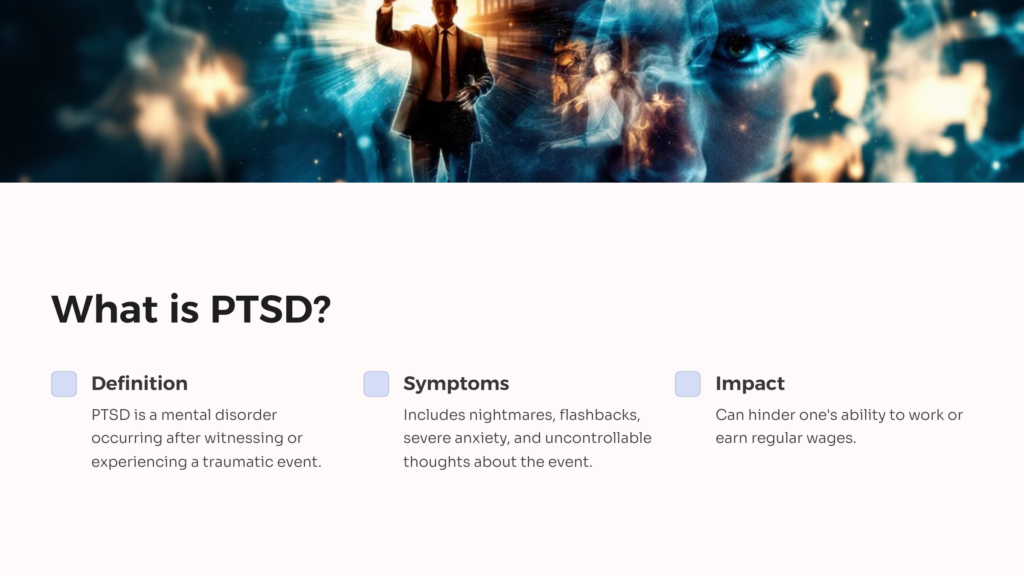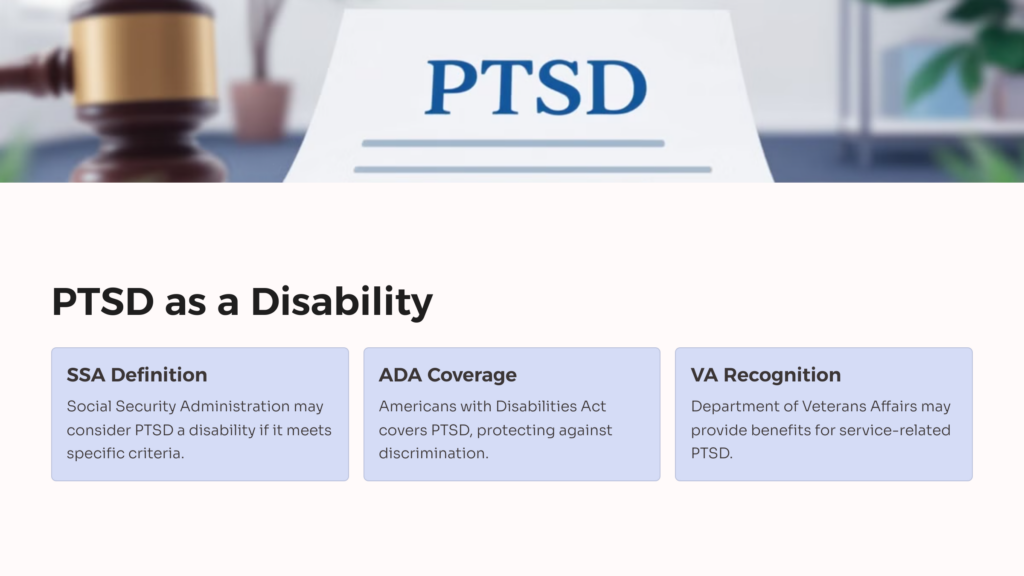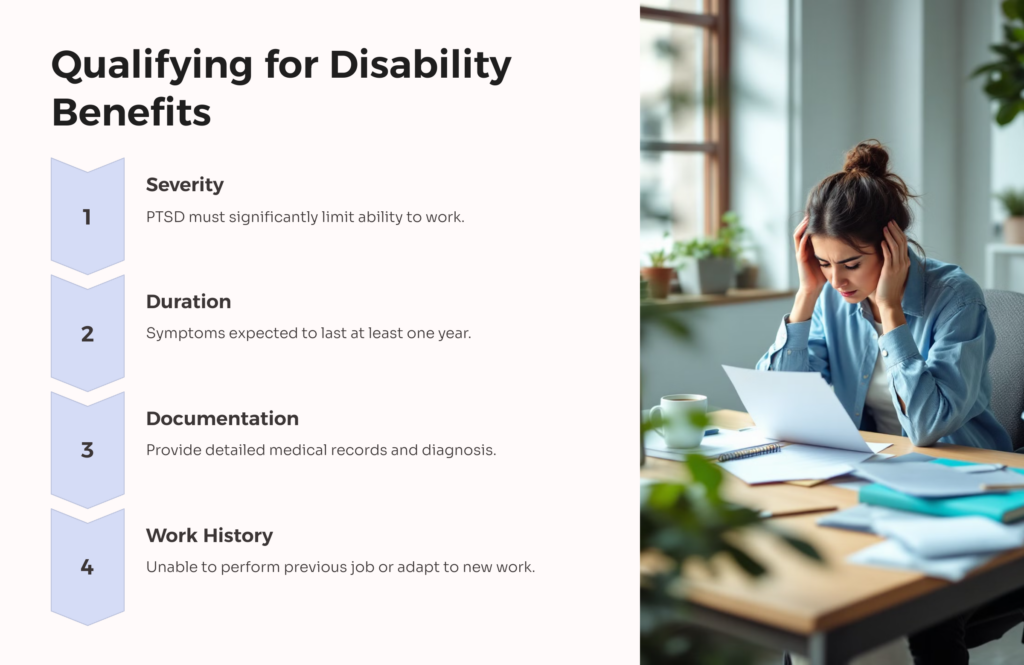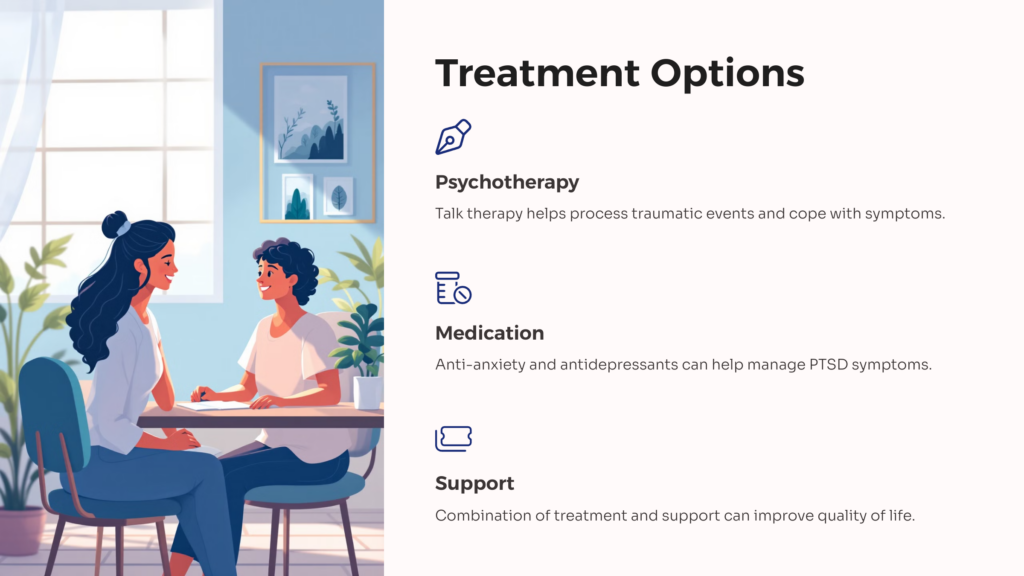Many people think of diseases and physical injuries when they think about disabilities. But a mental condition like post-traumatic stress disorder (PTSD) is also a disability. It can hinder one from going to work or earning regular wages. Most people suffering from this mental health condition either can’t find work or can’t perform their job-related activities.
Employees who have PTSD can pursue compensation through their Social Security disability or employer’s worker’s compensation insurance. If you meet the set conditions, you may receive disability benefits, which you need to cover medical treatment and supplement your lost income.
In this article, we’ll explore what PTSD is, whether it’s a disability, and how you can secure the disability payments you deserve if you have this mental disorder.
Understanding PTSD

PTSD is a mental disorder that occurs when one witnesses or has a traumatic experience. Symptoms might include nightmares, flashbacks, severe anxiety, and uncontrollable thoughts about the event.
Many people who experience or witness terrifying events might have temporary difficulty coping and adjusting; however, with time and good self-care, they may get better. If your symptoms worsen, last for several months or even years, and hinder your ability to function properly, you might have PTSD.
PTSD symptoms might start within a month of a traumatic event. However, sometimes, symptoms might not appear until years later. Often, PTSD symptoms cause severe problems in work, social situations, and even relationships.
Typically, post-traumatic stress disorder symptoms are grouped into four categories: avoidance, intrusive memories, changes in physical and emotional reactions, and negative changes in thinking and mood. Symptoms may vary from person to person or over time.
Symptoms of avoidance include:
- Avoiding thinking or talking about the event
- Avoiding people, activities, or people that remind you of the event.
Symptoms of intrusive memories include:
- Unwanted, recurrent distressing memories of the terrifying event
- Nightmares or upsetting dreams about the event
- Severe emotional distress or reactions to anything that reminds you of the event
- Flashbacks
Symptoms of shifts in emotional and physical reactions or arousal include always being on guard for danger, being easily frightened, indulging in self-destructive behavior including driving too fast or drinking too much, trouble concentrating, and trouble sleeping.
Finally, symptoms or negative changes in mood and thinking include difficulty maintaining close relationships, feeling emotionally numb, hopelessness about the future, lack of interest in activities you once enjoyed, and feeling detached from family and friends.
PTSD and Disability

The Social Security Administration defines PTSD as a disability in some cases. If post-traumatic stress disorder meets specific requirements in the Social Security Administration’s (SSA) Blue Book, one can file a claim for disability compensation.
According to the SSA’s Blue Book, PTSD is deemed as a disability if it meets the following criteria:
- Exposure to threatened death, death, violence, or serious injury
- Avoidance of reminders of the terrifying event
- Involuntary re-experiencing the trauma after the traumatic event, such as intrusive memories, flashbacks, or dreams
- Increase in reactivity and arousal, including trouble sleeping or exaggerated startle responses
- Disturbances in behavior or mood
The above conditions must be combined with these symptoms:
- A marked or extreme limitation of at least two of these mental functioning indicators:
- Remembering, applying, and understanding information
- Maintaining pace, persisting, and concentrating
- Interacting with others
- Managing oneself or adapting
- Or if the mental disorder is severe and persistent, the individual has medical documentation of the existence of the disorder for over two years, and there’s documented evidence of the following:
- The individual can’t adapt to changes in their environment or demands in their daily life
- Ongoing psychotherapy, medical treatment, psychosocial support, or a structured setting that reduces PTSD symptoms
To claim disability benefits, one must also meet work requirements set out by the SSA. SSDI (Social Security Disability Insurance) and other benefits are meant for those who cannot work due to the severity of the impairment of their disability.
Legal Perspective of PTSD as a Disability
The Americans with Disabilities Act (ADA) is a federal civil rights regulation that bars people from being discriminated against because of disabilities. It guarantees that those with disabilities enjoy the same opportunities as those without.
The ADA defines a person with a disability as one who:
- Has a physical or mental health condition that greatly limits at least one important life activity, including sleeping, eating, communicating, or walking
- Has a record or history of the impairment, including cancer that is in remission
- Is viewed by others as having an impairment, including having scars.
If one meets the above requirements, they’re automatically covered by the ADA. This act covers various disabilities, including post-traumatic stress disorder. That means PTSD is considered a disability, and those who have this mental condition can’t be subjected to PTSD disability discrimination.
If you’ve been diagnosed with post-traumatic stress disorder, you may be eligible for disability compensation. Like other mental health conditions, the SSA and VA have strict criteria for evaluating post-traumatic stress disorder, so qualifying for disability benefits isn’t always easy.

The VA is more likely to approve your PTSD disability claim if you suffer from another qualifying condition along with your PTSD, such as anxiety, depression, or insomnia. Additionally, if your PTSD resulted from a terrifying event while in military service that left you with physical injuries, you may qualify for disability benefits if your symptoms make it harder for you to work.
To qualify for PTSD disability benefits, you must provide extensive documentation to prove your PTSD meets all VA PTSD disability criteria. Working with a PTSD disability lawyer can also increase your chances of approval.
PTSD and Social Security Disability Benefits
PTSD might qualify for SSDI and work accommodations under the ADA (American Disabilities Act) if your symptoms affect your ability to work or complete everyday tasks.
Active duty members and veterans often suffer from PTSD. However, this mental health condition can also affect any individual who has witnessed or experienced a scary event. Examples might include gun violence, sexual assault, car accidents, spousal abuse, surviving a natural disaster, or kidnapping.
To qualify for SSDI compensation, the SSA requires you to meet the following conditions:
- Due to your post-traumatic stress disorder, you can’t perform any SGA (substantial gainful activity).
- You can’t do the job you previously did or adapt to other work because of your health condition.
- Your symptoms have lasted or are expected to last for more than one year or will cause death.
To make these determinations, the SSA asks these five questions:
- Can you work? If so, you should earn less than a specific dollar limit monthly. The SGA limit for 2024 is approximately $1,550 per month and $2,590 if you’re also blind.
- Is your mental condition “severe,” implying that for at least one year, it’ll significantly hinder your ability to stand, lift, sit, walk, or remember things?
- Is your health condition on the SSA’s list of disabling conditions it deems severe enough to hinder one from performing SGA?
- Can you do the job you did previously?
- Can you perform any other type of work? The SSA looks at your mental condition, as well as your education, age, transferable skills, and work experience.
Many veterans suffer from PTSD, and it often entitles them to veterans disability benefits. However, the SSA doesn’t always approve PTSD disability claims. SSA doesn’t always presume PTSD is service-connected, so submitting sufficient evidence is the key to successful PTSD disability claims.
That means ensuring you provide the SSA and the Department of Veterans Affairs (VA) with:
- Detailed medical documents that support your diagnosis and the seriousness of your symptoms. This includes medications, the doctor’s grounds for the diagnosis, and other treatment protocols your doctors have tried and their effects, symptoms, and limitations.
- A strong nexus letter from a knowledgeable medical professional. Considering there’s no presumed service relation, you’ll require a medical opinion to prove the connection between your PTSD and in-service stressors. A psychiatrist or psychologist is best because they’re competent to explain if your traumatic event may have caused your PTSD.
- Hire a qualified PTSD disability lawyer. Working with an experienced PTSD disability lawyer can significantly impact the outcome of your PTSD disability claim. A PTSD disability attorney knows the documentation the SSA and VA look for and the medical documents needed to get the disability benefits you deserve.
At AllVeteran, our team has been helping veterans with disabilities get the compensation they deserve for many years. Whether you want to file your initial application or appeal a denial outcome, we can help. Contact us today to learn how we can help.
Living with PTSD

Living with post-traumatic stress disorder is overwhelming. In this section, we offer practical suggestions for taking care of yourself:
- Medical treatment: PTSD treatment can help you regain control over your life. The primary treatment for this mental condition is psychotherapy, but you can also take medications. Combining these two forms of treatment can improve your symptoms by helping you think positively about yourself and others. Treatment can also help you treat other medical problems often related to traumatic experiences, such as anxiety, depression, or misuse of drugs and alcohol.
- Psychotherapy: Several forms of psychotherapy, often known as talk therapy, are used to treat adults and children who have PTSD. Common forms of psychotherapy used to treat PTSD include:
- Exposure therapy: This therapy can help you safely face situations and memories you find scary so that you can learn to cope with them efficiently. Also, exposure therapy is especially beneficial for nightmares or flashbacks.
- Cognitive therapy: This form of treatment helps you identify the ways of thinking that keep you stuck–like negative thoughts about yourself and the probability of traumatic events happening again. For post-traumatic stress disorder, this type of talk therapy is often used together with exposure therapy.
- EMDR (Eye Movement Desensitization and Reprocessing): This talk therapy combines exposure therapy with various guided eye movements, helping you process terrifying memories and change your reactions.
These forms of therapy can help regain a sense of control of lasting fear following a terrifying event. You and your therapist should discuss what treatment or combination of talk therapies best suits your needs.
- Medications: Several kinds of medications can improve your PTSD symptoms, including:
- Anti-anxiety medications: These drugs can ease severe anxiety and related issues.
- Antidepressants: These drugs can relieve symptoms of anxiety and depression. Also, they can improve concentration and sleep problems. The Food and Drug Administration (FDA) approves paroxetine (Paxil) for the treatment of PTSD.
You and your doctor should work together to determine the best drug with the fewest side effects that will help your particular situation and symptoms. After several weeks, you may begin to experience improvement in your mood and other symptoms.
With proper treatment, you can handle and mitigate your PTSD. For instance, Philip has had PTSD most of his life. However, he was not diagnosed correctly with this mental illness until age 35. His PTSD was triggered by many traumas, like sexual and mental abuse and an attack at knifepoint that left him almost dead. For a long time, he couldn’t close his eyes without seeing the face of his attacker. He suffered terrifying nightmares and flashbacks.
While PTSD is incurable, undergoing behavioral therapy and taking medication marked a significant turning point in his life. This allowed him to regain control over his life and rebuild a successful career as an artist.
Conclusion: Is PTSD Classified as a Disability?
Both the VA and SSA deem PTSD a disability in some cases. As long as your PTSD meets specific disability qualifications, including being diagnosed by a qualified doctor and it limiting or impairing areas of your life, you may be eligible for PTSD disability benefits.
Also, the ADA covers PTSD, which means it’s deemed a disability, and those suffering from it can’t be discriminated against.
Take our quiz today to get an accurate PTSD disability rating.
 AllVeteran.com Advisors
AllVeteran.com Advisors
With expertise spanning local, state, and federal benefit programs, our team is dedicated to guiding individuals towards the perfect program tailored to their unique circumstances.











